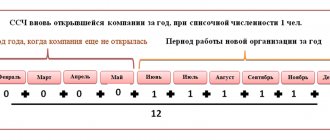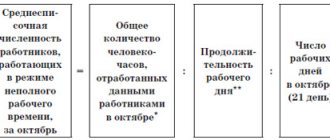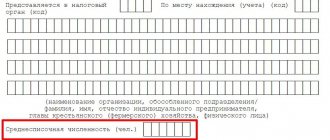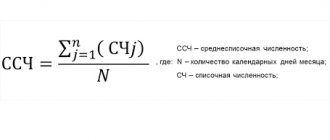List and attendance number of employees
The definition of payroll is clear from the name itself - this is the number of employees registered in the organization.
The number on the payroll coincides with the number of employees according to the working time sheet. This includes all employees, including remote workers, seasonal workers, employees on vacation, business trips, absent for health reasons, and temporary employees. The following categories of employees are not included in the average number:
- Performing work or providing services under GPC agreements.
- Working on an external part-time basis.
Attendance number is the number of personnel actually performing a labor function at the current time. The difference between the payroll and attendance indicators indicates the number of absent employees due to vacations and illnesses.
Calculation of turnout and payroll numbers
The turnout number can be adjusted to the payroll number and vice versa. The list and attendance of workers can be determined by the formula:
- Chsp = Chya x Ksp, Ksp - payroll coefficient is defined as the ratio of the organization's working time to the working time of an individual employee according to the production calendar.
The number of working days of an organization depends on the organization of the work process and work schedule. An enterprise operating in a continuous process environment will have more working days per year than an organization whose employees work from Monday to Friday.
An employee's working time is defined as the planned number of working days minus the vacation period.
The turnout is usually equal to or less than the list. The payroll is determined in the staffing table. The number of personnel is calculated based on production capacity, work process, and administrative resources. Different departments of the organization will have different ratios between payroll and attendance. Administrative staff typically work a five-day schedule. The number of regular and registered employees is approximately the same. But in production shops operating on a shift basis and process continuity, the number of workers who appear will be slightly less than on the list.
METHODS FOR CALCULATING THE NUMBER OF PRODUCTION PERSONNEL
Production personnel are workers directly involved in the process of creating material assets, as well as those engaged in repairs, moving goods, and providing services. Production personnel are divided into two categories:
- main (production of enterprise products);
- auxiliary (maintenance of the main production process).
Methods for calculating the number of workers depend on the standard or non-standard work they perform. The calculation of the number of workers is carried out by sections, workshops, and then for the enterprise as a whole. At the same time, the volume of work to be performed in standard hours is compared with the annual working time of one worker.
The following working time funds are distinguished:
- calendar (takes into account the total number of calendar days in a year);
- nominal (determines the number of possible working days in a year, equal to the calendar fund excluding non-working days);
- valid (different from nominal by the removal of unused time from it (vacation, illness, performance of government duties, etc.)).
To calculate the number of main workers, two complementary methods are used:
- according to labor intensity standards;
- according to equipment maintenance standards.
When calculating according to labor intensity standards, the number of main workers on the payroll ( Ksp ) is determined by dividing the labor intensity of the production volume in standardized hours by the actual working time of one worker:
Ksp = ΣNiti / Fd (i = 1, …, m), (1)
where Ni is the production program in physical terms;
ti is the planned labor intensity of a unit of production (work), taking into account the influence of organizational and technical measures implemented in the planned year;
Fd - actual time fund;
m is the number of products (works) performed by this group of workers.
It is necessary to distinguish between the payroll and attendance numbers of workers. The payroll, as a rule, is larger than the turnout, as it takes into account the additional number of workers to replace those on vacation, when performing government duties, etc.
The payroll number of the main workers of an enterprise is determined by dividing the labor intensity of gross output in standard hours by the actual working time of one worker; the number of workers present - divided by the nominal time fund.
When calculating the payroll, the payroll coefficient ( rsp ) is used, which is calculated as the ratio of the nominal time fund ( Fн ) to the actual time fund:
rsp = Fn / Fd. (2)
Using the payroll coefficient, you can derive the relationship between the payroll and attendance numbers of workers :
Ksp = Kav × rsp, (3)
where Kyav is the turnout number of workers;
KSP - payroll number of workers.
The number of main workers can also be determined by service standards and the number of units and machines, taking into account the shifts of their work. In this case, the turnout number is first determined, then the payroll (using the payroll coefficient).
The number of auxiliary workers is determined in two ways:
- according to service standards;
- according to the availability of jobs.
FOR YOUR INFORMATION
The service rate refers to the number of jobs or other units served by one worker. Calculation based on service standards is more accurate, but requires preliminary establishment of these standards.
To calculate the number of auxiliary workers by workplace, you need:
- make a list of jobs;
- determine the need for workers for each of them.
The enterprise's total need for workers is calculated by summing the number of main and auxiliary workers in all workshops and areas.
The number of engineering and technical workers (E&T), office workers and junior service personnel is established by drawing up the staffing table. The staffing table is drawn up in relation to the adopted production management scheme, the content and scope of work at each site. The number of many categories of engineers and employees, junior service personnel is determined by service standards, controllability standards, and by mathematical modeling.
By comparing the actual number of workers at the beginning of the planned period and the plan's demand at the end of the period, the additional personnel requirement ( Kdop ) is calculated. In this case, one should take into account the normal loss of workers (conscription into the army, transfer to another job, voluntary dismissal, retirement, etc.). The calculation formula looks like this:
Kdop = (Ksp – Kf) + Ksp × U / 100%, (4)
where Ksp is the number of workers on the payroll;
Kf - actual number of personnel at the beginning of the planning period;
Y is the planned percentage of staff attrition in the year.
Having determined the need for personnel, they draw up a plan to meet this need, that is, a balance of the workforce, a plan for training and advanced training.
EXAMPLE 1
Table 1 shows the calculation of the number of main production workers according to the labor intensity of manufacturing products.
| Table 1. Calculation of the number of main workers by labor intensity ( actual working hours - 1570 hours) | ||||||
| Product | Labor intensity of the annual production program, thousand standard hours | Units | Turners | Grinders | Locksmiths | Workers of other specialties |
| Product A | 148 | % | 29,30 | 19,54 | 9,77 | 41,39 |
| thousand hours | 43,4 | 28,9 | 14,5 | 61,3 | ||
| Product B | 95 | % | 25,00 | 35,00 | 5,00 | 35,00 |
| thousand hours | 23,8 | 33,3 | 4,8 | 33,3 | ||
| Product B | 48,5 | % | 40,00 | 22,00 | 11,00 | 27,00 |
| thousand hours | 19,4 | 10,7 | 5,3 | 13,1 | ||
| Total | 291,5 | thousand hours | 86,5 | 72,8 | 24,5 | 107,6 |
| List number of workers | 55 | 46 | 16 | 69 | ||
| Expected number of workers at the beginning of the planning period | 51 | 48 | 13 | 56 | ||
| Surplus of workers (–)/shortage of workers (+) | 4 | –2 | 3 | 13 | ||
Four categories of workers are involved in the production of goods (A, B and C) : turners, grinders, mechanics, and workers of other specialties.
For each product, it is known what percentage of time workers of each category spend on its production. Accordingly, it is possible to calculate how long turners, grinders, mechanics and other workers must work in order to complete the annual production program.
For example, the total labor intensity of the annual program for the production of product A is 148 thousand standard hours. Of the total number of standard hours, 29.3% is accounted for by the work of turners (148 thousand hours × 29.3% = 43.4 thousand hours); 19.54% - work of grinders (148 thousand hours × 19.54% = 28.9 thousand hours); 9.77% - work of mechanics (148 thousand hours × 9.77% = 14.5 thousand hours); 41.39% - labor costs of workers in various specialties (148 thousand hours × 41.39% = 61.3 thousand hours).
We carry out similar calculations for all products and find that workers need to work 291.5 hours , including:
- turners - 86.5 thousand hours;
- grinders - 72.8 thousand hours;
- mechanics - 24.5 thousand hours;
- workers of other specialties - 107.6 thousand hours.
The actual time fund of one worker is 1570 hours . Based on this, the payroll number of workers will be :
- turners - 55 people. (85.6 thousand hours / 1570 hours);
- grinders - 46 people. (72.8 thousand hours / 1570 hours);
- mechanics - 16 people. (24.5 thousand hours / 1570 hours);
- workers of various specialties - 69 people. (107.5 thousand hours / 1570 hours).
Comparing the payroll number of workers with the expected number at the beginning of the planning period, we come to the conclusion that we have an excess of grinders (2 people) and a shortage of other workers: 4 turners, 3 mechanics and 13 workers of various specialties.
EXAMPLE 2
Table 2 shows the calculation of the number of auxiliary workers according to service standards.
| Table 2. Calculation of the number of auxiliary workers according to service standards, people. | |||||||||
| Profession | Workplace/serviced unit | Number of workstations/units | Standard of service | Number of shifts | Turnout number of workers | Payroll ratio | Scheduled number of workers according to plan | Expected number of workers at the beginning of the planning period | Surplus of workers (–)/shortage of workers (+) |
| Duty mechanic | Machine tools | 150 | 2 | 12 | 1,25 | 15 | 14 | 1 | |
| Crane operator | Overhead electric cranes | 2 | 1 | 2 | 4 | 1,21 | 5 | 3 | 2 |
The calculation was carried out for two professions: duty mechanic and crane operator. The mechanics on duty service the machines (150 pcs.). The service norm per mechanic is 25 machines. The company operates in two shifts. Based on these data, we calculate the turnout number of workers :
150 pcs. / 25 pcs. × 2 shifts = 12 people.
Payroll ratio - 1,25.
We use formula (3) and determine the payroll number of workers :
12 people × 1.25 = 15 people
The expected number of mechanics on duty at the beginning of the planned period is 14 people. Hence the need for on-duty mechanics - 1 person.
We will carry out similar calculations for crane operators. The need for crane operators is 2 people.
Attendance and payroll number of employees: calculation example
Let's consider a conditional example: the enterprise has 50 machines, 4 people are needed to service one machine. Work is carried out around the clock in 4 shifts. The average annual working time of one employee is 325 days. We will calculate the turnout and payroll numbers.
The minimum number of workers required to ensure the process is the turnout number. The company has 50 machines, which employ 4 people at a time in 4 shifts. Thus: Chya = 50 x 4 x 4 = 800.
The payroll includes all employees who are registered at the enterprise. Using the formula, it will not be difficult to determine the payroll:
- Chsp = Chya x Ksp,
- Ksp = 365 / 325 = 1.123,
- Chsp = 800 x 1.123 = 898.
The payroll will be 898 people, and to ensure continuity of the work process, the attendance of 800 people is required.
This formula determines the need for personnel, taking into account vacations and illnesses of workers.
Headcount analysis helps to properly plan personnel management, calculate costs and prevent downtime in the work process. You can find more complete information on the topic in ConsultantPlus. Free trial access to the system for 2 days.
Calculation of attendance, staffing and payroll numbers of main and production workers
The attendance number of main workers per day Rav/day is determined by the formula:
Ryav/day = M x C, (9)
where M is the number of jobs for this category, pcs.,
C - number of shifts depending on the shift schedule, pcs.
Staffing number of main production workers Rsht people. determined by the formula:
Rsht = Ryav/day + substitution, (10)
where Rav/day is the number of attendance per day, people.
The coefficient of reduction of staffing levels and payroll numbers of the Kpr is determined by the formula:
Kpr = Tnom / TEf, (11)
where Tnom is the nominal working time fund, in days,
Teff is the effective working time fund in days.
The payroll number of main production workers Rsp people. determined by the formula:
Rsp = Rsht x Kpr, (12)
where Rsht is the staffing number of main workers, people,
Kpr – staffing reduction factor, people.
The turnout is calculated using formula 9:
Ryav/day = 3 x 1 = 3 people.
The staffing number of key production workers is determined as the number of attendance per day plus substitution:
Rst = 3 + 1 = 4 people.
The coefficient for bringing the regular number of workers to the payroll number of the Kpr is determined for the transition of the regular number of workers to the payroll number, it will be:
Kpr = 277/241 = 1.15
Let's determine the headcount:
Rsp = 4 x 1.15 = 5 people.
We summarize the obtained data in a table5
Table 5 - Turnout, staffing and payroll numbers of main production workers.
| Name of specialties | Shift schedule | Shift duration | Tariff category | Turnout number of workers in | Number of replacement workers | Staffing number of workers, Rsht | Reduction coefficient and headcount | List number of workers | |
| shift | day | ||||||||
| 1 Operator | 3 | 8 | 6 | 1 | 3 | 1 | 4 | 1,15 | 5 |
| 2 Decomposition operator | 3 | 8 | 6 | 1 | 3 | 1 | 4 | 1,15 | 5 |
| 3 Decomposition operator | 3 | 8 | 5 | 2 | 6 | 2 | 8 | 1,15 | 9 |
| 4 Cooking operator | 3 | 8 | 5 | 1 | 3 | 1 | 4 | 1,15 | 5 |
| 5 Cooking operator | 3 | 8 | 4 | 1 | 3 | 1 | 4 | 1,15 | 5 |
| 6 Dosing operator | 3 | 8 | 5 | 1 | 3 | 1 | 4 | 1,15 | 5 |
| 7 Dosing operator | 3 | 8 | 4 | 1 | 3 | 3 | 6 | 1,17 | 3 |
| 8 Neutralization operator | 3 | 8 | 5 | 2 | 6 | 2 | 8 | 1,15 | 9 |
| 9 Pumping unit operator | 3 | 8 | 5 | 1 | 3 | 2 | 5 | 1,15 | 6 |
| 10 Drying operator | 3 | 8 | 5 | 1 | 3 | 1 | 4 | 1,17 | 5 |
| 11 Drying operator | 3 | 8 | 4 | 2 | 6 | 2 | 8 | 1,15 | 9 |
Payroll calculation for main production workers
Calculation of the wage fund of the main production workers Zt, r. produced according to the formula:
Zt= Cht x Tsm x Tef x Rsp, (12)
where Thu is the hourly wage rate for a worker of this category, rub.,
Tcm - duration of the shift, in hours,
TEF is the effective working time fund of one average worker, in days,
Rsp - payroll number of workers, people.
Calculation of the amount of bonus for main production workers Zprem, r. produced according to the formula:
Zprem = (Zt x Pprem) x 100, (13)
where Zt is wages, rub.,
Pprem - bonus percentage according to the current bonus system for chemical enterprises, r.
Calculation of the amount of additional payments for work at night Znoch, r.
The time from 10 pm to 6 am is considered night time. When working around the clock, the number of night hours should be no more than 8 hours. Therefore, night time accounts for 1/3 of the wage fund according to the tariff. The student takes an additional payment for night time - 50% of the salary fund.
Value = (3t / 3) x 50 (14)
Additional payment for work on holidays (Zpraz) is determined by the formula:
Zpraz = Thu x Tsm x Tpraz x Ryav/day, (15)
where Tpraz is the number of holidays per year, in days,
Rav/day - the number of workers of this category in attendance per day, people.
Calculation of basic salary Zosn r. produced according to the formula:
Zosn = Zt + Zprem + Znoch + Zpraz, (16)
Calculation of payment according to the tariff coefficient is made using the formula:
3r.k. = (Zosn x Kr)/100, (17)
where Kr is the regional coefficient, r.
Calculation of additional wages
Additional wages are paid for time not worked: payment for regular vacation, student leave, performance of government duties.
Calculation of vacation 3otp, r. produced according to the formula:
3otp = (3osn + Zr.k.) / Tnom x Totp, (18)
where 3osn is the basic salary, rub.,
Zrk - payment of the regional coefficient, rub.,
Ттп — number of vacation days, in days.
Calculation of student leave Zuch, r. determined by the formula:
Zuch = (Zosn + Zr.k.) / T nom x Tuch, (19)
where Tuch is the number of days of student leave, in days.
The calculation of payment for government duties is carried out similarly to the previous one.
Additional salary Salary, rub. determined by the formula:
Zdop=Zotp +Zuch +3G.0. , (20)
where Zg.o. – Calculation of payment for government duties, rub.
Annual wage fund GFZP r. calculated by the formula:
GFZP = Zosn + Zr.k + Zdop (21)
Calculation of contributions to the Unified Social Tax, Unified Social Tax, rub. produced according to the formula:
UST = (GFZPx27.5)/100 (22)
The attendance number of main workers per day Rav/day is determined by the formula:
Ryav/day = M x C, (9)
where M is the number of jobs for this category, pcs.,
C - number of shifts depending on the shift schedule, pcs.
Staffing number of main production workers Rsht people. determined by the formula:
Rsht = Ryav/day + substitution, (10)
where Rav/day is the number of attendance per day, people.
The coefficient of reduction of staffing levels and payroll numbers of the Kpr is determined by the formula:
Kpr = Tnom / TEf, (11)
where Tnom is the nominal working time fund, in days,
Teff is the effective working time fund in days.
The payroll number of main production workers Rsp people. determined by the formula:
Rsp = Rsht x Kpr, (12)
where Rsht is the staffing number of main workers, people,
Kpr – staffing reduction factor, people.
The turnout is calculated using formula 9:
Ryav/day = 3 x 1 = 3 people.
The staffing number of key production workers is determined as the number of attendance per day plus substitution:
Rst = 3 + 1 = 4 people.
The coefficient for bringing the regular number of workers to the payroll number of the Kpr is determined for the transition of the regular number of workers to the payroll number, it will be:
Kpr = 277/241 = 1.15
Let's determine the headcount:
Rsp = 4 x 1.15 = 5 people.
We summarize the obtained data in a table5
Table 5 - Turnout, staffing and payroll numbers of main production workers.
| Name of specialties | Shift schedule | Shift duration | Tariff category | Turnout number of workers in | Number of replacement workers | Staffing number of workers, Rsht | Reduction coefficient and headcount | List number of workers | |
| shift | day | ||||||||
| 1 Operator | 3 | 8 | 6 | 1 | 3 | 1 | 4 | 1,15 | 5 |
| 2 Decomposition operator | 3 | 8 | 6 | 1 | 3 | 1 | 4 | 1,15 | 5 |
| 3 Decomposition operator | 3 | 8 | 5 | 2 | 6 | 2 | 8 | 1,15 | 9 |
| 4 Cooking operator | 3 | 8 | 5 | 1 | 3 | 1 | 4 | 1,15 | 5 |
| 5 Cooking operator | 3 | 8 | 4 | 1 | 3 | 1 | 4 | 1,15 | 5 |
| 6 Dosing operator | 3 | 8 | 5 | 1 | 3 | 1 | 4 | 1,15 | 5 |
| 7 Dosing operator | 3 | 8 | 4 | 1 | 3 | 3 | 6 | 1,17 | 3 |
| 8 Neutralization operator | 3 | 8 | 5 | 2 | 6 | 2 | 8 | 1,15 | 9 |
| 9 Pumping unit operator | 3 | 8 | 5 | 1 | 3 | 2 | 5 | 1,15 | 6 |
| 10 Drying operator | 3 | 8 | 5 | 1 | 3 | 1 | 4 | 1,17 | 5 |
| 11 Drying operator | 3 | 8 | 4 | 2 | 6 | 2 | 8 | 1,15 | 9 |
Payroll calculation for main production workers
Calculation of the wage fund of the main production workers Zt, r. produced according to the formula:
Zt= Cht x Tsm x Tef x Rsp, (12)
where Thu is the hourly wage rate for a worker of this category, rub.,
Tcm - duration of the shift, in hours,
TEF is the effective working time fund of one average worker, in days,
Rsp - payroll number of workers, people.
Calculation of the amount of bonus for main production workers Zprem, r. produced according to the formula:
Zprem = (Zt x Pprem) x 100, (13)
where Zt is wages, rub.,
Pprem - bonus percentage according to the current bonus system for chemical enterprises, r.
Calculation of the amount of additional payments for work at night Znoch, r.
The time from 10 pm to 6 am is considered night time. When working around the clock, the number of night hours should be no more than 8 hours. Therefore, night time accounts for 1/3 of the wage fund according to the tariff. The student takes an additional payment for night time - 50% of the salary fund.
Value = (3t / 3) x 50 (14)
Additional payment for work on holidays (Zpraz) is determined by the formula:
Zpraz = Thu x Tsm x Tpraz x Ryav/day, (15)
where Tpraz is the number of holidays per year, in days,
Rav/day - the number of workers of this category in attendance per day, people.
Calculation of basic salary Zosn r. produced according to the formula:
Zosn = Zt + Zprem + Znoch + Zpraz, (16)
Calculation of payment according to the tariff coefficient is made using the formula:
3r.k. = (Zosn x Kr)/100, (17)
where Kr is the regional coefficient, r.
Calculation of additional wages
Additional wages are paid for time not worked: payment for regular vacation, student leave, performance of government duties.
Calculation of vacation 3otp, r. produced according to the formula:
3otp = (3osn + Zr.k.) / Tnom x Totp, (18)
where 3osn is the basic salary, rub.,
Zrk - payment of the regional coefficient, rub.,
Ттп — number of vacation days, in days.
Calculation of student leave Zuch, r. determined by the formula:
Zuch = (Zosn + Zr.k.) / T nom x Tuch, (19)
where Tuch is the number of days of student leave, in days.
The calculation of payment for government duties is carried out similarly to the previous one.
Additional salary Salary, rub. determined by the formula:
Zdop=Zotp +Zuch +3G.0. , (20)
where Zg.o. – Calculation of payment for government duties, rub.
Annual wage fund GFZP r. calculated by the formula:
GFZP = Zosn + Zr.k + Zdop (21)
Calculation of contributions to the Unified Social Tax, Unified Social Tax, rub. produced according to the formula:
UST = (GFZPx27.5)/100 (22)







